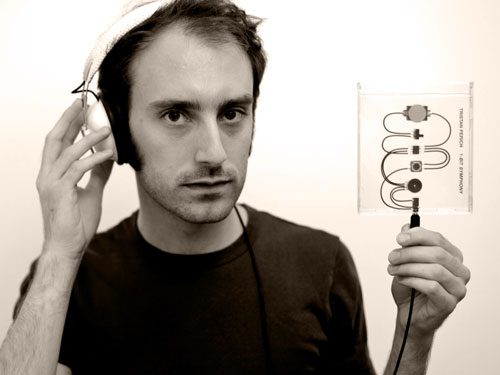During the weekend of April 29 - May 1, Tristan Perich, a New-York based composer/artist, came to Oberlin's Frank-Lloyd Wright House and Cleveland's SPACES Gallery to present a modernist extravaganza.
Serenity and unyielding power are nature’s most elegant and alluring facets. That is why, when mixing elements of a computer (a purely human-derived contraption) along with the natural composure of sound found in acoustic instruments, Tristan Perich receives the attention he does. Both quietly intriguing and beautiful, Perich’s work 1-Bit Music is powerful in its sophisticated design which embodies the concept of naturalness. Returning to the origin of electronic music, Perich incorporates square sound waves which interplay between electrical states 1 and 0. He applies the philosophies of mathematicians Kurt Gödel and Werner Heisenberg which revolve around the idea that if something is consistent, then it is never complete. Perich, driving this notion in 1-Bit Music, delivers a fascinating sonic display of cyclical motion. Acoustic sounds intermingle with electronic ones that, at certain moments, bring out distinct lines of pulsations and tones which transfix the listener.
Minimalist at its core, Perich’s 1-Bit Music contains its own rhythm which feels primitive, and this combined with his layering of oscillations between electronic and acoustic sounds, creates an effect where specific beeps and pulsations stick out over others. This affect is felt most powerfully in his first piece titled Observations for two sets of crotales, three-channel 1-bit music (2008). This implementation was developed by the interaction between the acoustic sounds presented in the crotales (which were played by Oberlin Conservatory students Austin Vaughn and Ryan Packard) and the electronic noises. Each voice (electronic or acoustic) stopped completely to allow each other to shine at explicit landmarks in the composition. All together, the effect was bewitching.
Consistency, drive, and the interplay between electronic and acoustic sound waves thrived throughout Perich’s presentation. Three other compositions included: Momentary Expanse for solo vibraphone with two-channel 1-bit music (2008), qsqsqsqsqqqqqqqqq for three toy pianos and three-channel 1-bit tones (2009), and Dual Synthesis for harpsichord and four-channel 1-bit electronics (2009).
Upon hearing Dual Synthesis, Perich’s ideal of circular motion, natural rhythm, and the interaction between acoustic and electronic sounds were brought to a higher level of fruition. Synthesis (the longest) was a grandiose polyphony of circular motion allowing the individual sounds of the harpsichord to be heard, which would in response, invite the four-channel 1-bit electronics to solo as well. At distinct points, harpsichord and electronics would convene in unison, and the result was mesmerizing. Portions of the circle (or circular motion) conveyed by Perich’s 1-Bit ideal were distinguishable and clever. Impressive on harpsichord, Daniel Walden was illustrated this effect tactfully and with tireless vigor.
As an event spanning over three venues (Frank Lloyd Wright’s Weltzheimer-Johnson House, SPACES Gallery in Cleveland, and Fairchild Chapel -- cancelled due to an emergency in Perich’s family), 1-Bit Music is only one counterpart of Perich’s 1-Bit Project which incorporates his visual art as well.
Beginning at the Wetzhimer-Johnson House, 1-Bit Music depicted an enchanting atmosphere which permitted the audience to be surrounded by nature and the ambience of home. It was as though listeners were experiencing a premier of Haydn or Liszt especially with the application of the harpsichord and toy pianos.
Made possible through the funding of the Oberlin Creativity Fund and the Meet The Composer’s Metlife Creative Connections Program, the 1-Bit Project is, hopefully, a beginning towards bridging the gap between musicians and visual artists at Oberlin.

No comments:
Post a Comment